“It is easy for me to imagine that the next great division of the world will be between
people who wish to live as creatures and people who wish to live as machines.”
― Wendell Berry, Life is a Miracle
Anyone who has spent time following discourse surrounding the topic of technology will find much concern, enthusiasm (or ambivalence) falling into several major categories. Oft discussed are smartphones, social media, screen-based learning, dating apps, pornography, ChatGPT, LLMs, and AI of various kinds and degrees. Their issues are legion and we must heed warnings of them. These developments hold potential of harm to psyche and soul, our views of sexuality, cultural transmission of values or lack thereof, relationship formation, cognitive development, loneliness, and more. Still, despite the importance of seriously grappling with these prominent technologies, we must also devote attention and careful consideration to a somewhat neglected (but no less important) topic: medical technology.
Here we will examine how western society has come to approach the deeply human matters of medicine while ruled by the ideology of machines. Using Neil Postman’s book Technopoly, special consideration will be given to matters of fertility and mortality as it relates to his chapter The Ideology of Machines: Medical Technology.
When it comes to our human relationship with any sort of technology, Jeffrey Bilbro has noted that any analysis “must build on a coherent anthropology, a robust understanding of who humans are and what our telos is.” This coherent anthropology has historically been provided by religion and philosophy, often in tandem. This understanding has lagged behind—or been warped and forgotten— amidst the dizzying pace of technological change, leaving no facet of life untouched. For context, Postman juxtaposes our moment in time with the changes wrought by the printing press. While drastically changing communication and society, culture had around 200 years to settle into that new normal before the next major society-altering inventions.
Our current moment commands intense consideration of fertility and mortality. Matters of life and death have always pervaded societies, yet the techniques available today have eroded much of the givenness—and many of the natural guardrails—long associated with the good purposes of reproduction and sexuality, along with the expectations associated with life’s beginning and life’s end. Our former tools have given way to, as Postman puts it earlier in the book, “the idea that if something could be done it should be done.”1 and traditional thought-worlds are therefore made to be “invisible and therefore irrelevant… so that our definitions fit the new requirements.”2
The way in which a Technopoly operates is not, therefore, by way of neutrality.
In fertility and mortality, evaporating natural limits have left a void. What fills it, providing those new requirements? What now grounds our understanding of these experiences of the human person? What role does the practice of medicine play in our collective understanding of health, dignity, control, morality?
In her journal article What is Medicine For? Kristin Collier provides a compelling image to hold urgent questions: “Consider an analogy. Modern scientific medicine is like a massive boat propelled by cutting-edge technology. The boat is impressive, moves expediently, travels great distances, but in which direction and towards what destination? Science and technology alone cannot know. The metaphysical thing you do not see, which directs the boat to its proper, good destination, is the rudder of philosophy. This philosophical rudder is essential for aligning the direction of science and technology with the good goals of medicine. Who is attending to the philosophic rudder of medicine today? The powerful and profitable tools of science and technology, though necessary to medicine as a profession, have created a myopic lens through which medicine’s gaze has been captivated for at least a century and probably much longer.”
Indeed, one could read her entire paper as a response to Neil Postman’s chapter The Ideology of Machines: Medical Technology. The thirty year gap only increases its prescience. Postman states, “Philosophers may agonize over the questions “What is truth?” “What is intelligence?” “What is the good life?” But in Technopoly there is no need for such intellectual struggle. Machines eliminate complexity, doubt, and ambiguity. They work swiftly, they are standardized, and they provide us with numbers that you can see and calculate with.”3
Matters of our fleshy, embodied life are with each of us constantly. No one evades them. So what are we to do with the streamlined, standardized methods which have encroached into the most delicate and ontological of human experiences? Medical science itself cannot tell us. Where do the goals and limits of modern medical practice now come from… and how did we get here?
In this chapter, Postman looks at historical vignettes which highlight the changing perception and work of physicians. He begins with the invention (or discovery) of the stethoscope in the early 1800’s. By today’s standards, such a simple tool could be seen as laughably benign. Yet he explains, “A somewhat less trivial objection raised by doctors was that if they used an instrument they would be mistaken for surgeons, who were then considered mere craftsmen. The distinction between physicians and surgeons was unmistakable then, and entirely favorable to physicians, whose intellect, knowledge, and insight were profoundly admired.”4
Here we glimpse the last vestiges of a long-standing perception of physicians. This is reflected in the social deference bestowed to the discipline over the “mere craftsmanship” of surgeons. The sharp distinction reflects the purpose of physicians as compared to surgeons, including the disposition and qualities necessary for each profession at the time the stethoscope came into the picture.
Postman continues, describing how the introduction of certain instruments changed the physician’s encounter with patient: “But a serious objection raised by physicians, and one which has resonated throughout the centuries of technological development in medicine, is that interposing an instrument between patient and doctor would transform the practice of medicine; the traditional methods of questioning patients, taking their reports seriously, and making careful observations of exterior symptoms would become increasingly irrelevant. Doctors would lose their ability to conduct skillful examinations and rely more on machinery than on their own experience and insight.”5
Taken on its own, one could argue the benefits of various machines and instruments which aid physicians in their healing. Indeed, few people desire to go back to an age before life-saving measures and myriad advancements have been a mercy to us all. Imperceptible changes came with the way the use of such tools altered the emphasis given to examining disease over the patient as a whole—and objective knowledge over the subjective. The introduction of the stethoscope was the beginning of an ever-accelerating change in the work of physicians.
In summarizing the mental shift, Postman explains that now, “Medicine is about disease, not the patient. And, what the patient knows is untrustworthy; what the machine knows is reliable.”6 Postman goes on, positing that “subjective forms of knowledge have no official status, and must be confirmed by tests administered by experts. Individual judgements, after all, are notoriously unreliable, filled with ambiguity and plagued by doubt… Tests and machines are not.”7
Dangers abound in eliminating the incalculable, relying excessively on metrics. As physician Josh Briscoe asserts, “Health has both objective and subjective facets. You can’t just look through one facet. You may miss an insidious tumor if only you relied on a patient’s symptomatic reports. You may ride rough-shod over someone’s existential distress if you only saw the normal tests and scans. What does it look like to pursue health in obstetrics, pediatrics, psychiatry, oncology, hospice, and so on? What does health look like with cancer, with bipolar disorder, with quadriplegia, with Trisomy 13? We’re so inclined to let our metrics, given to us by our technology, and our diagnoses lead the way that we may miss opportunities to see, sustain, and restore health.”
We go on to learn from Postman how the further parceling out of specialized tasks and procedures inevitably changed the way information was gleaned. This change altered the relationship of medical providers to patients, and the physician’s own learned skills and insight. Postman continues, “By the turn of the century, medicine was well on its way to almost total reliance on technology, especially after the development of diagnostic laboratories and the discovery and use of antibiotics in the 1940’s. Medical practice had entered a new stage. The first had been characterized by direct communication with the patient’s experiences based on the patient’s reports, and the doctor’s questions and observations. The second was characterized by direct communication with patients’ bodies through physical examination, including the use of carefully selected technologies. The stage we are now in is characterized by indirect communication with the patient’s experience and body through technical machinery. In this stage, we see the emergence of specialists — for example, pathologists and radiologists – who interpret the meaning of technical information and have no connection whatsoever with the patient, only with tissue and photographs. It is to be expected that, as medical practice moved from one stage to another, doctors tended to lose the skills and insights that predominated in the previous stage.”8
It is worth considering what assumed skills and insight doctors lost in the fragmentation wrought by specialization. The most prominent might be the interplay of the physical with the emotional, mental, and spiritual. It isn’t entirely reasonable to expect a majority of providers working in our current medical system to have the ability—or time—to attend to all facets of the human person. We can be enormously grateful for specialists seeking excellence in their professions, even as we hope they are also formed in the humanities. The specialist’s labors toward healing require intricate understanding, focused research, and diligent, dedicated time. The quality of our health has truly benefitted.
At minimum, a skill to revive and fiercely protect would be points of initial contact with patients. In his essay, In Defense of Human Doctors, physician Brewer Eberly notes, “There remains an assumption that it only takes that long – through prewritten templates, skillful interruptions, and tortured rituals of expectation-setting (“we only have time to discuss one problem today”) – for the necessary data to be strip-mined from the patient’s story.” Yet he implores, “When it comes to the first moves of primary care, in which we are often welcoming patients to speak of their sufferings for the first time, silence may be the most intelligent form of communication we have.”
As “indirect communication” has become commonplace, however, our expectations of being met in suffering still rely on other people—not machines—to bear witness to it. Medical professionals and society at large each play a role in recognizing the one in distress. In the words of Leah Libresco Sargeant, “Women are particularly vulnerable to pressure to make their ailments conform to expectations… Without actively intending it, people in distress rely on our expectations of illness to find a way of being recognized.”
What do we expect responses to illness and ailments to look like?
In matters of women’s health, this most often looks like menstrual complaints being met with assurances of pain being “normal” or given a prescription to suppress their cycle with hormonal contraception, instead of a solution to the root cause. In matters affecting procreation, couples are routinely told to endure three miscarriages before a traditional provider will—potentially, and not always—look into causes of miscarriage or infertility. Even so, many women and couples end up being handed the vague non-diagnosis of “unexplained infertility” and shuffled along to IVF, bypassing a path toward health altogether. Caitlin Estes, a Certified FertilityCare Practitioner, captures the experience with many OBGYNs as “a shockingly short journey from “Oh, don’t worry: just come back if you haven’t conceived in a year… I’ll probably see you next month!” to “There’s nothing more we can do for you. We recommend trying IVF.” What happens in between is often rushed, chaotic, confusing, and a bit soul crushing. You go in with the determination to do whatever it takes, but it’s not long before you’re wondering if it should really be asking so much of you physically, mentally, and spiritually.”
In matters pertaining to end of life, this looks like illness and ailments—whether of the body, mind, or social support—increasingly being seen as a mark of “eligibility” for voluntary death. An opposite approach to death includes unrealistic expectations of artificially prolonged life at any cost. Both approaches resist a truly good death, meeting challenges with either a heavily controlled extension or termination of life.
Devoid in these cases of women’s health, reproduction, and death is an acknowledgment of the just support due the suffering of persons. Acknowledgement of the finite and dignifying limits we ought to work within are, however, vital.
Continuing on, we are introduced to a shadow side of this ability to specialize, particularly paired with the American ethos. Postman notes how America, from its earliest stages, looked upon European medical methods as “mild and passive.” By contrast, Americans “accepted the imperative to intervene, to mistrust nature, to use the most aggressive therapies available.”9 Side effects from such aggressive approaches now “can be solved only by the further application of technology.”10 Citing common procedures in medicine today, he follows with the astounding rates of interventions required to deal with their ramifications.
The compounding cycle is, in many cases, perpetuating its own problems.
As for the healthcare women routinely receive, you don’t have to look far to hear stories of the reverberating side effects of hormonal contraceptives. This is a realm of research finally gathering steam and credibility, as the excessive prescription of the pill has left behind mental, relational, and physical harm requiring further damage control. The ubiquitous use of hormonal birth control often leads to depressive symptoms requiring antidepressants to manage, some of which routinely alter the experience of sexuality for huge swaths of their users. As for end of life care, aggressive approaches commonly result in further ailments needing tending to. For those terminally ill or in natural decline, these are tender and complex realities to navigate. The most dignifying of palliative care can help temper the painfully prolonged cycle of technological interventions necessitating each other.
We are told that “As the training of doctors changed, so did the expectations of patients.”11 As such, “if a patient does not obtain relief from a doctor who has failed to use all the available technological resources, including drugs, the doctor is deemed vulnerable to the charge of incompetence… Moreover, doctors are reimbursed by medical-insurance agencies on the basis of what they do, not on the amount of time they spend with patients.”12 Here we have a vicious, mutually reinforcing cycle. Is it any wonder we come to expect aggressive, automated, plug-and-play care unless taught or shown otherwise?
As a result of these morphing innovations and subsequent expectations, “There are no longer methods of treating illness; there is only one method – the technological one. Medical competence is now defined by the quantity and variety of machinery brought to bear on disease.”13 If earlier adoption of this method was utilized with less technological finesse, we now have the mechanical precision beyond prior belief.
But not all medical competence aims toward health. Not all methods seek dignified wholeness. Not all medical practices and procedures are free of machine thinking. Rightly ordered agency gets eclipsed by illusions of control.
Take, for instance, the basic physiology in women of childbearing age. Their cycle has four distinct phases: follicular, ovulatory, luteal, and menstrual. These impact the mood, energy, creativity, and emotion of women in various ways. As with the four seasons, perpetual sameness wouldn’t serve nature well. The dancing interplay of shifts in weather, flora, and fauna—including the hidden activity at work even in winter—reflect the female body. While research has moved forward proving the necessity of menstrual cycles for long-term health—including their importance as the “fifth vital sign” of overall health—girls and women (and the men who love them) are still routinely left in the dark about the workings of their bodies. They are prescribed hormonal contraceptives for everything from acne to birth control to painful or irregular periods (at alarmingly young ages). The implication of such an approach by medical providers is that female reproductive issues are irrelevant until procreation is a concern, menstrual cycles are optional (not integral), and symptoms temporarily patched and suppressed aren’t important enough to address for the sake of overall health.
Machines have on/off switches. Female physiology should not. It is complex yet understandable. Being more like a garden and in need of similar attention, it strains, revolts, and withers when treated in uniformly programmed ways.
As L.M. Sacasas contends, regarding the generally cold and impersonal standardization in modern life, “Of course if you insist that the human being operate like a machine, with the efficiency of the machine, with the regularity of the machine, the predictability of the machine, the fleshy creature breaks down, rejects that, reacts against that, and we’re beginning I think to feel that more implicitly or more viscerally…”
If “Medical competence is now defined by the quantity and variety of machinery brought to bear on disease,” then what has anchored medicine, undergirding its own telos? The Hippocratic Oath, while never a universal given, was historically a source of unity among medical practitioners. Acknowledging the current tension, L.S. Dugdale explains that “Oaths make clear what kind of art doctors practice… yet, the question is not simply whether the medical profession is moral, but what kind of morality it professes. In a divided world, physicians must seek unity on the fundamentals.”
Even so, physician Brewer Eberly has identified three challenges for talking about health: Not agreeing on what health is, the medical instrumentalization of what we talk about, and the collective vision of health—the “communities that make love coherent and possible.”
In medical practice, we observe this incongruence in the primacy of the male body (or hormonally flattened female body) in research trials. The lack of medical training to identify biomarkers of fertility in women’s cycles, aiding a picture of overall health. The ubiquity of hormonal contraception as the uniformly offered solution to women’s menstrual ailments. As FertilityCare Practitioner Caitlin Estes aptly points out, “When physicians aren’t even taught how to properly understand, diagnose, or treat underlying medical issues that cause infertility, it’s not surprising that vulnerable women are then sent off to “fertility specialists” who have learned the science of bypassing much of the body’s physiology. When you don’t understand something, you can’t work with it—you just have to work to control it.”
We also see these challenges confusing the end goals of women’s health, where healing and restoration of health is substituted with circumvention and violent creation. As the manifesto Stop Hacking Humans succinctly explains, "The lab setting then opens the door to further extensions of body hacking, all the while leaving the underlying condition unresolved.”
We see yet more instrumentalization of human experience in the growing markets for egg and sperm. The procedures involved with undergoing In Vitro Fertilization. The practices of intense genetic testing, ranking, sex selection, or modification of pre-implanted embryos. The worldwide surrogacy market. The research into artificial wombs. The bestowing of legal parenthood after the assembled patchwork of composite material and processes to create a child. The assumptions inherent in first trimester genetic screening. Elective abortion—of naturally conceived children, or those carried by surrogates and not up to quality-control standards. Stem cell research and use of aborted fetal remains. Indefinite storage or destruction of frozen embryos.
We also see these three challenges Eberly describes when considering the navigation of life’s end—namely, decisions around whether and how to artificially extend life or whether to entertain assisted suicide. Ethan Schimmoeller writes of our modern wrestlings: “Where death cannot be defeated, its authority can be subdued by professional discourse and once more recapitulate medicine’s drive to master death. Taken together, our novel surrogates for traditional ways of caring for the dying unite to deny and evade death, despite the irony of admitting the technological limits of medicine.”
Lack of agreement on the definition of health, plus a utilitarian pragmatism—combined with an absence of communities of love—leaves ready ground for an ever-expanding instrumentalization of human experience.
These challenges have, overall, tilted toward one side of the equation. Embodied friction is currently met with a well-oiled path to the achievement of desires, ease for medical providers, or the benefit of the medical system at large. Optimization of this path becomes the norm. In the words of L.M Sacasas, “The implicit demands of our social structure—economic and technological—is that the body is a point of friction, that hampers the efficiency of the system, the overall techno-economic system.”
Postman acknowledges the stranglehold these developments have had on medical practice at the systemic and granular levels, and therefore how dissatisfied many physicians were even three decades ago. He notes that “Doctors themselves feel restricted and dominated by the requirement to use all available technology.”14
This could very well be applied to the minutiae of today’s electronic medical record documentation, the tests and methods used out of an abundance of caution to avoid malpractice, as well as morally dubious practices affecting sexuality and the delicate beginnings and ends of life. It seems there is no terrain of traditional, modern healthcare untouched by Technopoly. The current systemic models of profit above all have crushed the spirits of many medical professionals. Those who entered with hopeful aspirations of patient-centered healing have become disillusioned with the simultaneous limitations and requirements set upon them. As a result, incredible numbers of professionals are leaving healthcare, as physician Edwin Leap recounts. Those who remain are often themselves in need of mending, indications of a lack of nurturing formation and humane expectations along the way.
Brewer Eberly also quotes from Technopoly that “In the eternal struggle between God and Mammon, the clock quite unpredictably favored the latter.” He contends that if medicine is an art like music, modern practices have condensed and truncated the proper sound of it. Seeing people and assisting them toward health is complex. “Like a song, suffering cannot be hurried along.” Thus, his direct primary care practice has sought to “inhabit a musical relationship with time.”
How are people handled from embryonic stage until last breath? What care do the elderly and infirm deserve? Should children be assembled and tweaked products? How ought we define their parents? What is our definition of health? What does health look like for girls, women and their hormonally complex bodies? What is sexuality for? Are gametes and wombs raw material used toward the end result of the reproductive process? What are children owed? How do we navigate death?
Collier elsewhere posits, “If medicine is no longer working from a divine anthropology, what then happens when learners are given big terms and concepts that are important to patients and medicine: terms like “justice,” “humane,” “dignity,” “compassion,” “ethics,” or even “person?” Modern medicine, with only a mechanistic anthropology, cannot possibly have any idea what these terms really mean because they are no longer rooted in the source that renders them intelligible concepts. These words are often thrown around during professionalism lectures, but they are mostly understood, if at all, only in a vague, hollow sense.”
Absent an anchoring telos, the void is always filled. Answers come by way of standardized technique. The echo of its answer often resounds with the hollow ringing of dehumanization. Altruism is often the veneer.
Oliver O’Donovan, in his 1984 book Begotten or Made?, a treatment of personhood and the fitting boundaries of reproductive techniques, identifies how a blind virtue of compassion—when untethered from anything beyond itself—can become the driving motivator for action: “Compassion is the virtue of being moved to action by the sight of suffering–that is to say, by the infringement of passive freedoms. It is a virtue that circumvents thought, since it prompts us immediately to action. It is a virtue that presupposes that an answer has already been found to the question “What needs to be done?,” a virtue of motivation rather than of reasoning. As such it is the appropriate virtue for a liberal revolution, which requires no independent thinking about the object of morality, only a very strong motivation to its practice.”
Our crisis is partly one of a reductive vision of the created person. And a person is not just a body, but a soul. According to the Catechism of the Catholic Church, our personhood is wrapped up in a body-soul unity, a composite of the two. We are more than mere matter. Personhood ought not be reduced to biological functions severed from the soul. This approach is an affront to human dignity. Here is where the spark of Technopoly’s intrusion ignites all manner of disagreement, confusion, and incoherence in the modern practice of medicine, the handling of our bodies.
Postman notes in an earlier chapter that Tool-Using Cultures did not see tools as intruders. “They are integrated into the culture in ways that do not pose significant contradictions to its world-view… Medieval theologians developed an elaborate and systematic description of the relation of man to God, man to nature, man to man, and man to his tools. Their theology took as first and last principle that all knowledge and goodness come from God, and that therefore all human enterprise must be directed toward service of God. Theology, not technology, provided people with authorization for what to do or think.”15
However, in clarifying the transition from Tool-Using Cultures to Technocracies, he states that “tools play a central role in the thought-world of the culture. Everything must give way, to some degree, to their development.”16 Lastly, in the transition from a Technocracy to a Technopoly we develop “the idea that if something could be done it should be done”17 and that traditional thought-worlds are made to be “invisible and therefore irrelevant. It does so by redefining what we mean by religion, by art, by family, by politics, by history, by truth, by privacy, by intelligence, so that our definitions fit the new requirements. Technopoly, in other words, is totalitarian technocracy.”18
Today we are offered a kind of magic. And absolute control is our modern version of magic.
Postman explains, “What is significant about magic is that it directs our attention to the wrong place. And by doing so, evokes in us a sense of wonder rather than understanding. In Technopoly, we are surrounded by the wondrous effects of machines and are encouraged to ignore the ideas embedded in them. Which means we become blind to the ideological meaning of our technologies.”19
Mary Harrington has explored the ongoing religious, philosophical, and political dynamics of how we relate to human nature, drawing “on the first half-century of the transhumanist era—an era that began with the contraceptive pill—to show that much of the contemporary confusion within the Right concerning technology, and especially biotechnology, stems from the coexistence within the conservative coalition of two mutually incompatible metaphysical paradigms for the “human”: one that assumes humans have a stable nature and another in which no such nature need be assumed.”
Where do medical techniques, procedures, and approaches go beyond assisting toward health, wholeness, and dignity? When do they cross into the realm of creating new narratives—about the givenness of life? The reality of human nature? The meaning and purpose of our physical bodies?
Physician Josh Briscoe explains the current challenge of parceling out the moral and practical aspects of medicine: “This is the subtle education clinicians get throughout training and onward for the rest of their careers: ethics is what you do when something goes awry. Everything else… is just normal. This siloing of ethics into a land of quandaries and conflicts lulls us into believing that there aren’t other processes that shape how we come to see and even generate those quandaries and conflicts.”
Fortifying this line of thought, Postman writes, “Undeniably, fewer and fewer people are bound in any serious way to Biblical or other religious traditions as a source of compelling attention and authority, the result of which is that they make no moral decisions, only practical ones.”20
If theology was once more formative and influential than any useful tools or experts of the day, it begs the question of whether this is still true today.
Pope Paul VI’s 1968 encyclical Humanae Vitae, along with the 1987 Donum Vitae, 1995 Evangelium Vitae, and 2008 Dignitas Personae, have perhaps been the most clearly defined and religiously authoritative writing—and John Paul II’s Theology of the Body one of the most comprehensive—on matters of embodiment, sexuality, procreation, and the dignity of the person within Christianity. Their prescience remains, with a wide appreciation for their stabilizing influence. Contemporary moral challenges have, however, illuminated holes in the lack of widely-held and authoritative Protestant stances on ethics surrounding matters of procreation—though some have been acknowledging and seeking to fill these holes in moral formation regarding the body generally and assisted reproductive technology in particular. Calls for good Protestant ethicists have been made, alongside explanations of reasons for the lack.
Catholic teaching has inspired innumerable books aiming to form thought and practice in the medical disciplines. Lawyer and bioethicist O. Carter Snead similarly draws on such principles in his popular-level book, What It Means to Be Human. It contrasts the prevailing expressive individualism at play in abortion, artificial reproductive technologies, and end-of-life issues with our human networks of “uncalculated giving and graceful receiving.”
Preserving or restoring these networks of uncalculated grace might be the most humane work set before us. Here is where we’re shown another way, outside of calculated thinking. Here are places where we give and receive in accordance with the teeming life—and unknowns of death—in our midst. Briscoe elsewhere reminds us, “Being human also means being frail, vulnerable, and mortal. It doesn’t tarnish our dignity to acknowledge these realities or live under them.”
Harrington also connects the “biolibertarian” thread between women despising their own offspring—a natural consequence of sex—to the despising of any life thereafter: “Full term abortion and euthanasia on demand don’t just demand to control the stuff of life itself. Such measures also attack the presumption that we are directed toward one another: that humans are relational beings.”
When it comes to embracing the intricately uncontrollable reality of our reproductive systems or the trials of a good death, networks of human community are indispensable.
We ought to revive the principles of ars moriendi (“the art of dying well”), suggests Lydia Dugdale, internal medicine physician and medical ethicist at Columbia University. In her book The Lost Art of Dying, readers are shown how the ars moriendi tradition—which originated with Christians living through the Black Plague—starts with living well. Dugdale’s emphasis on human dependence and mutuality in a good death is poignantly summed up when she writes, “community does not materialize instantly at a deathbed; it must be cultivated over a lifetime.”
Additionally, she is honest about modern medicine’s barriers to this kind of good death, suggesting a rekindling of virtues necessary for the dying to meet those challenges. Dugdale suggests that dying well necessitates coming to terms with our mortality, living and dying amidst others, combating an excessively medicalized death, approaching death with courage, conceding to our bodily frailty, and respecting the spiritual.
When it comes to our penchant for fragmented and manufactured reproduction, Kerri Christopher writes of the existential questions we would rather not confront: “When it does work, IVF bequeaths to a child some uncomfortable truths: that he has his origins in an act of masturbation rather than sexual union; that doctors selected him from among his siblings as the most likely to survive; that his siblings were thereafter discarded, or remain on ice. He will spend his life wrestling with how his existence—something objectively good—could come from something so distorted. If his mother used a sperm donor, this child might spend his adult years trying to find his half-siblings, or even his father. He’ll be grateful to be alive, but deeply confused about what family means. For the rest of her life, his mother will carry these weights in her soul.”
These are disturbing quandaries which a respect for rightly-ordered limits would mitigate. The proper bounds of creatures ought to be nestled within human networks of “uncalculated giving and graceful receiving” which interdependence provides. This approach excludes no one, and aids the flourishing of all.
Gritty blessedness can and should be seen in those living lives of overflowing familial abundance and physical health, to be sure. However, those living lives of singleness, infertility, or disability—along with our common experience of the end of life—offer their own unique, needed witness to this goodness. We are free to acknowledge suffering. If we will eschew the allure of resolving lack with a mechanized dehumanization, we can find a richer experience in the enveloping care of others.
As Wendell Berry illustrates regarding the particular case of a beloved, dying Burley Coulter in his short story Fidelity, “they thought with regret of the time when the thing that was wrong with him had been simply unknown, and there had been only it and him and him and them in the place they had known together. Loving him, wanting to help him, they had given him over to “the best of modern medical care”—which meant, as they now saw, that they had abandoned him.”
Our finite selves need the riches of belonging and shared virtue. These are more vital to a humane society than promises of life and death on our tightly grasped terms.
Demanding these fiercely managed terms often leave us committing “ontological violence,” as Michael Hanby has described it. However, a full-throttle “violence against the order of nature has consequences, whether we face them or not. Suppressed questions return, often with a vengeance.” What ontological questions are we suppressing? What consequences can we expect once the blinders of denial come off?
Postman comments, “Through it all, the question of what was being undone had a low priority if it was asked at all. The Zeitgeist of the age placed such a question in a range somewhere between peevishness and irrelevance.”21 Innovations and the availability of normalized procedures march forward, irrespective of moral qualms and pesky existential concerns.
In the case life’s end, the mere availability of assisted suicide (euthanasia, Medical Aid In Dying) puts the onus on others to justify their own existence. For the woman carrying a child with Downs Syndrome, what kind of freedom is there to say no to abortion when the assumed norm says otherwise? In the case of the conception machine’s use of donor gametes and surrogate carriers, or the creation, handling, selection, and modification of embryos—perhaps artificial wombs in the future—what it means to be human is now ostensibly up to individual will.
But the option of control weighs heavy on all sides. Our personhood is no longer infused with transcendent meaning, and instead subject to rational calculation. The availability of a normalized choice—to systematize the process of creating and ending life—transforms itself into a heavy expectation.
But these offers of a forced mastery put us in denial of our finitude, making us anxious. Physician Brewer Eberly notes how with more technical expertise in the realm of medicine and death comes increased grasping for control. And this grasping is accompanied by denial and anxiety. These twin temptations cause us to either attempt extending life indefinitely or hasten death prematurely. The same could be said for attempts to circumvent the proper and given functions of the body.
Denial and anxiety in the realms of procreation often manifest similarly to those facing death. Control can manifest in fleeing, running from, avoiding—or alternatively seeking out, hastening, forcing. Fear is a good motivator. How much of medical care fosters an attitude of fearful grasping (physical, social, ethical ramifications be damned)?
Chilling yet self-evident is Postman’s statement that “Technological change is neither additive nor subtractive. It is ecological… It changes everything.”22 Mass availability and acceptance of a given medical technology creates inescapable scales of change. Though agency on an individual level remains, the reverberations throughout culture are not easily avoided.
For instance, Pope Paul VI recognized that something detrimental to the body-soul unity of sexual expression might also be detrimental to society at large. In this case, the source of downstream ills could be said to be the very modern notion of an assumed physiological separation of the unitive and procreative aspects of even married sexuality—whether through chemicals, devices, or surgeries. Widespread social change since the availability of the pill—combined later with other medically invasive contraceptive, abortive, and reproductive technologies—have vindicated the warning, if nothing else has. An assumption of physical sterility has been the source of no end of trouble, whether physiological, social, relational, or moral.
The resulting cascade of practices in medicine and norms in culture would not be possible without the medically sterilized unbundling of the unitive and procreative goods of sex. The objectification of women as objects of sexual pleasure and the objectification of children as engineered products are, indeed, two sides of the same coin.
As for death, the extremes of indefinite, artificial extension at any cost and abrupt extermination via euthanasia are both slow-burning phenomena. They arrived with welcome advances in medicine, but alongside a loss of theological and spiritual anchors for preparing for death—anchors which communally understood practices such as ars moriendi had provided.
Our approach to fertility and sexuality, death and mortality all share the fate of ecological transformation. “Like some well-known diseases, the problems that have arisen as a result of the reign of technology came slowly and were barely perceptible at the start.”23
We can note the dependency of second (and third) wave feminism on the erasure of embodied sex differences, as opposed to substantial moral progress.
We observe the detrimental social effects of ubiquitous, physiologically-altering contraception on casual sex, pornography, and the formation of marriages. Many are shrewdly rethinking the sexual revolution’s tradeoffs, indignantly recognizing the observable, studied effects of hormonal birth control on the body, brain, and interpersonal relationships, and learning of the necessity of real and healthy menstrual cycles.
We see how the ubiquitous use of hormonal birth control has led to poor mental health, often requiring antidepressants—many of which routinely and permanently alter the experience of sexuality for huge swaths of its users.
We experience the lack of training medical students receive for understanding, diagnosing, and treating underlying causes of reproductive health issues. Abortion and birth control are touted as the pinnacle of women’s health, while knowledge of (and care for) the basics of female physiology remain astonishingly elusive. Organizations such as FACTS seek to help professionals in traditional medicine fill these gaps, starting with fertility awareness-based methods. There could be a glimmer of hope for the hormonal intricacies of women to be routinely attended to. In the meantime, women are able to seek out Natural Reproductive Technology and Restorative Reproductive Medicine for practitioners trained accordingly, the efforts of which the Ethics and Public Policy Center has recently platformed.
We hear the women routinely being dismissed, ignored, or given meager band-aid solutions like the pill. Instead of investigative answers to their health complaints, they might receive drastic care when it’s too late. (The average time for a woman to receive a diagnosis for endometriosis is somewhere between three to eleven years.) The exclusion of menstruating, pregnant, and breastfeeding women from research trials—as documented in the book Invisible Women—creates gaps in vital knowledge for women’s health. Finding cures to pregnancy-related ailments such as hyperemesis gravidarum are given far less weight than the availability of automated sterility.
We can reflect on the inherent assumptions of prenatal screening. The procedures, process and implications for personhood inherent in IVF. The dehumanizing markets for even “elite” eggs and sperm or the normalization of freezing one's own eggs. The routine practices of genetic testing and sex selection of embryos, paving the way to a modern eugenics facilitated by products such as test kits for whole-genome sequencing—perhaps with IVF supplanting natural procreation “as the responsible method for producing children” in the future. The moral quandaries inherent in surrogacy’s exploitation of women, along with its disposability of children not up to contracted, quality-control standards. The inevitability of artificial wombs appears immanent, along with the normalization of children engineered from composite parts, with parents defined more by family law than natural obligations. Undesired children are aborted, desired ones become manufactured products. We eschew life through violence on our bodies and new ones, yet also force them into existence through more of the same.
We observe the increasing acceptance and implementation of legal assisted suicide (or euthanasia, Medical Aid In Dying). The vulnerable are now ushered toward death, despite noncompliance with its legal implementation. We even have suicide pods, the bleakest image of our cultural ennui. But death always has a social dimension implicit in it, despite assisted suicide being framed as patient autonomy. We can rightfully ask how churches ought to approach the euthanasia experiment where it is legal, and how we all can advocate for and participate in better end of life care.
Flattening the unruly aspects of a teeming humanity is something a machine can do quite efficiently. An approach of conquest is always more streamlined than nurtured care. Bypassing the goodness available within embodied limits skews toward dehumanization of the person. And there are always interrelated and compounding ramifications: physical, social, spiritual.
These ecologies can be changed or destroyed in a brief period of time, as we see in nature and in culture. Destruction is always easier, after all. Creation and cultivation toward health is more complex. Humans are complex. Care of the person requires attention and time ordered toward health, wholeness, and dignity.
Pope Francis captured the spirit of this approach in his description of such people as “artisans of the common good.” Dignified care of the body-soul unity—the art of attending to the whole of the person—is not lucrative, nor is it able to be supported on a mass scale with our current systems. Wendell Berry likewise writes in his book The Unsettling of America, “I conceive a strip-miner to be a model exploiter, and as a model nurturer I take the old-fashioned idea or ideal of a farmer. The exploiter is a specialist, an expert; the nurturer is not. The standard of the exploiter is efficiency; the standard of the nurturer is care. The exploiter's goal is money, profit; the nurturer's goal is health…”
Postman summarizes his conclusion of the chapter with three observations: “First, technology is not a neutral element in the practice of medicine: doctors do not merely use technologies but are used by them. Second, technology creates its own imperatives and, at the same time, creates a wide-ranging social system to reinforce its imperatives. And third, technology changes the practice of medicine by redefining what doctors are, redirecting where they focus their attention, and reconceptualizing how they view their patients and illness.24
The reigning ethos today is one of dominance, exerting complete mastery over nature. Moreseo than dignified agency working with our givenness toward true health, anything less than the utmost control over our bodies is increasingly seen as unacceptable. But absolute control is the language of machines. We are a composite of body and soul, human persons made for love, belonging, and wholeness. The cultivation necessary for this requires investigation, time, and intimate knowledge. It allows for—even requires—a high standard of agency as opposed to a steamrolled dominance.
Fear is a great motivator. We often choose, on the one hand, to seize the promise of control by fleeing from or suppressing the reality of fertility and mortality. Or we may choose, on the other hand, to grab hold of control by way of seeking out, hastening, or forcing these experiences in an effort to seize that which we feel we are owed when it comes to procreation and death.
We ignore finitude to our own and others’ detriment. The gift of our bodies, the begetting of life, and the embrace of a creaturely death can all be warped into something beastly. In a grimly mocking way, that beast returns uncontrollable.
We would do well to remember the proper agency we do have. Postman reminds us that even in the midst of a medical Technopoly, there remains “what the individual can do irrespective of what the culture is doing; and what the culture can do irrespective of what any individual is doing.”25 We are constrained to varying degrees by the ecology forming around us, but we still have our choices to make. Will we choose to be more human or machine? We ought to reckon with our own limits of embodiment, reveling in the givenness of human nature and of life itself. Unburdened from the tyranny of instrumentalization, we might just find a humane freedom.
A warm thanks to
for—several months back—extending the offer to to work through this chapter of the book (and then reading and making preliminary suggestions). Though the Technopoly read-through ended up having to be cancelled, I’m grateful for the nudge to put some long-marinading thoughts and other people in conversation with Postman.Postman, Neil. Technopoly: The Surrender of Culture to Technology. Vintage Books, 1993, p. 42
Ibid., 48
Ibid., 93
Ibid., 98-99
Ibid., 99
Ibid., 100
Ibid., 93
Ibid., 100-101
Ibid., 97
Ibid., 103
Ibid., 105
Ibid., 101-102
Ibid., 102
Ibid., 103
Ibid., 25-26
Ibid., 28
Ibid., 42
Ibid., 48
Ibid., 94
Ibid., 79
Ibid., 106
Ibid., 18
Ibid., 106
Ibid., 106
Ibid., 182


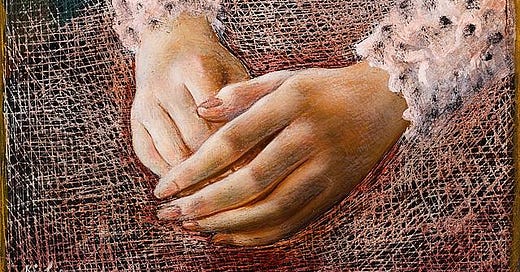


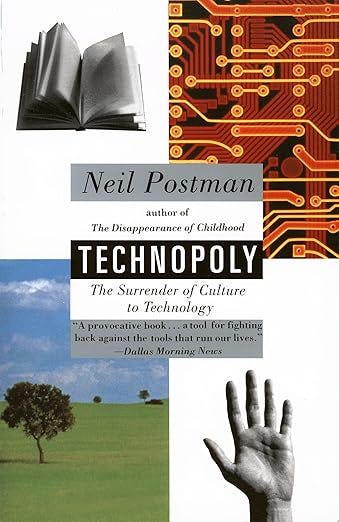

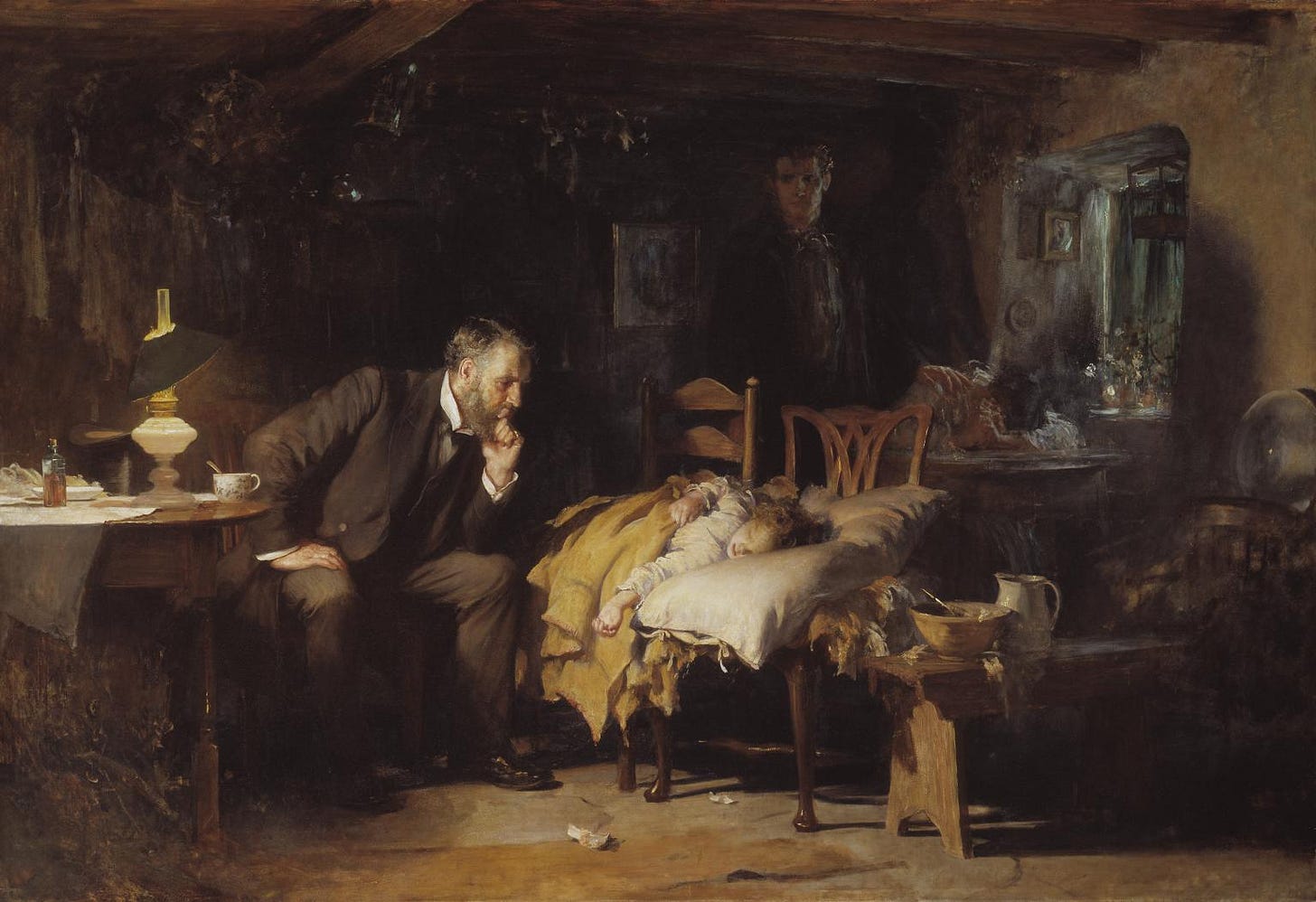




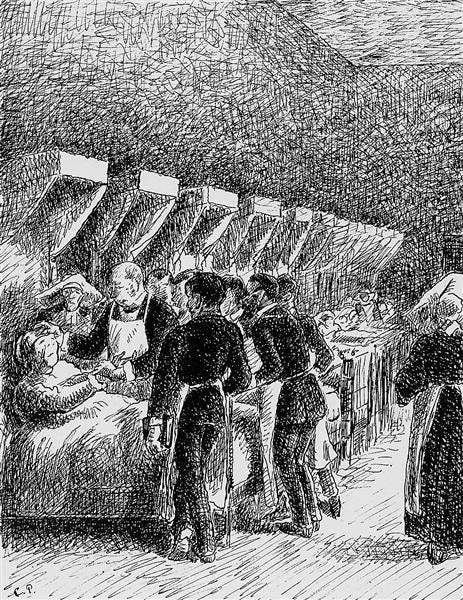
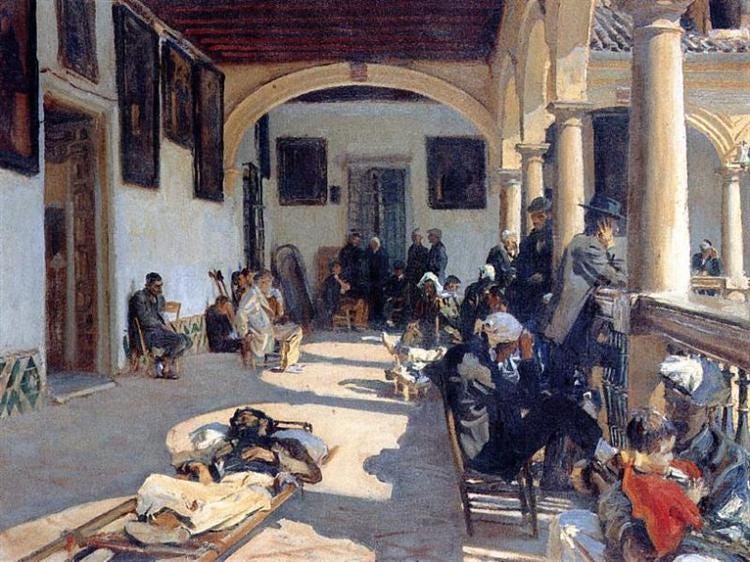
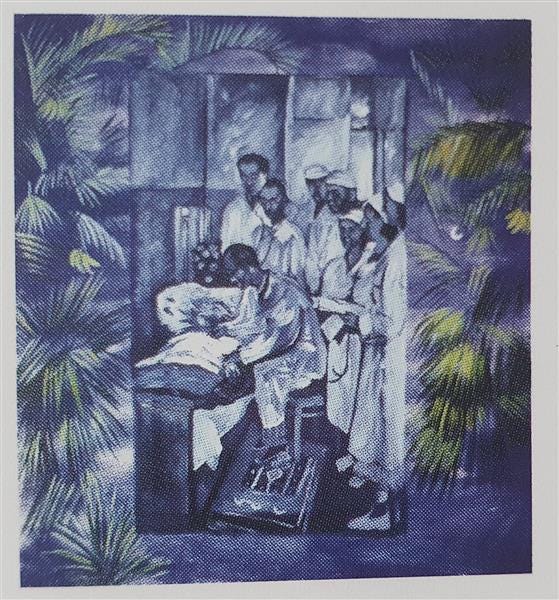


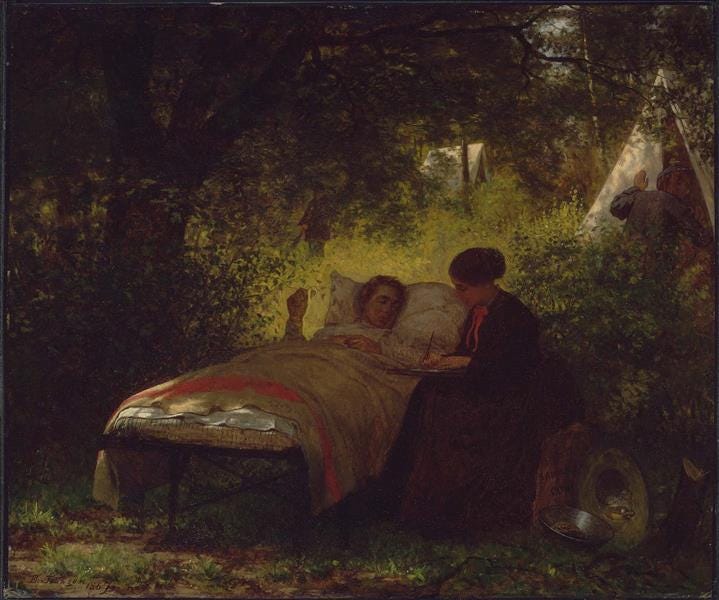


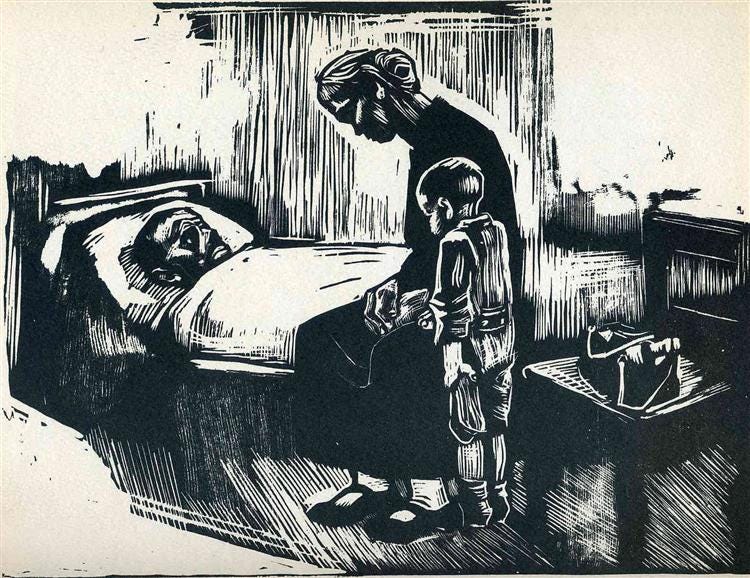


Haley, this is an AMAZING article that belongs in an academic journal. Incredibly well-done, richly sourced, and beautifully written. And you have me reading Wendell Berry! This is such an amazing resource and something I also care deeply about. If you wrote a book I would be first in line to buy it!
This was so very impressive and informative from start to finish. I second Kelly's comment as well! You could easily publish this in an academic journal (and I would be second in line to buy the book).